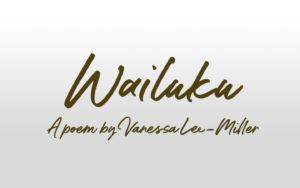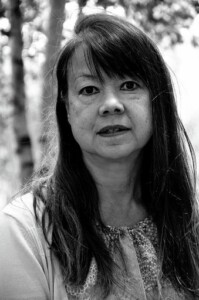This summer, Historic Hawai‘i Foundation launched a virtual art exhibit entitled Serendipity: Expressing the Connection of People, Place and the Past to showcase art inspired by historic places in Hawai‘i. Artists of all ages and experience were welcome to submit works of visual art, including collages, drawings, paintings, photography, printmaking, and poetry.
Wailuku, a poem by Vanessa Lee-Miller is especially captivating, capturing the mysterious power of the Wailuku River and the mo‘ōlelo it is associated with. 28 miles long, the Wailuku River flows downward from the eastern slope of Mauna Kea to Hilo Bay, where it joins the Pacific Ocean. It is the longest river in the Islands and is known for the scenic points of Waiānuenue (Rainbow) Falls and Boiling Pots.
Poet, playwright and freelance journalist Lee-Miller is a native of Hilo and grew up with the river in her backyard. Her poem exhibits an intimate awareness of its enchanting beauty.
Please enjoy her reading of Wailuku and the insights she shared about it.
Wailuku
by Vanessa Lee-Miller
Wailuku,
the raging kahawai,
the river.
Her kāholo,
Her long sinuous journey
begins,
as a watery,
pencil-thin line,
a mere trickle.
Mauka,
way up high,
looking towards
nā lani,
on Mauna Kea.
Her ‘auana
is a graceful journey iho,
downslope,
towards rainy Hilo.
‘Ae, Hilo,
i ka ua kanilehua.
As she continues to iho,
journey downslope,
a magical transformation ensues
from her embodiment
of a graceful,
delicate trickle.
She widens,
becoming voluptuous,
she’s now a raging beast,
plunging
turbulently
downward,
full of ʻenaʻena.
Capable of arbitrarily grasping
in her watery fist,
a young, reckless life
and smuggling it
into one of her
many deep,
cavernous pockets,
in her slimy “ana”.
She’ll stash it there,
it’s hers,
until the pale, lifeless form
struggles
through a multitude
of tempestuous undercurrents
to surface
somewhere iho,
downslope.
But,
during the course of her journey,
she leaves a trail
of dazzling performances.
After week
upon week
of infinite drops of rain
from nā lani,
awestruck malihini
call these wonders
Pi’ihonua Camp Cascades,
Boiling Pots,
Rainbow Falls.
Old Hawai’i calls them
Poakana,
Koakanini,
Pe’epe’e ,
Waiānuenue.
She weaves
ever so gracefully
skirting around sacred,
smooth boulders
leaving her mossy footprints
of slippery limu.
She continues to
‘auana.
In the wee hours of the morning,
from my Hāmākua-facing bedroom window,
I hear her
raging,
bellowing
sounds.
Drowning out
the lonely,
searching calls
of the small scaly river creatures
of the night.
Searching
in blind rage,
she leaves no boulder,
no jagged rock,
no slimy pebble
unturned.
River Moʻo waits,
watching
her every move,
hearing her belches and snorts and eerie releases.
He, shaking out the raindrops from his mane
of writhing eels,
belts out a wicked laugh
“Get plenny time”, he says,
slowly
sharpening
his battle-ready claws
against
the skull boulder.
He waits,
patiently,
for the right
moon.
Oh Wailuku,
you watery,
undulating
wahine aliʻi!
Once a graceful trickle
from nā lani .
You’ve morphed
into a skull crusher.
You stone carver,
you moʻo slayer,
so bloodthirsty
for the fearless,
sweet-weed-scented
swimmer.
Or was it the claw
of the moʻo
of the rain-drenched cave
of goddess Hina,
that dragged
da young buggah
into the murky depths?
Upon reaching her deep, dark, limu-laden
green mouth,
Makaolanakila.
She forcefully
surrenders
her full, swollen self
plunging
once more
into the wide,
stormy bay.
Both river and sea currents
reluctantly mingle.
She truly is
what Old Hawai’i called her,
destructive waters.
Wailuku , the river,
life-giving, life-grasping,
ruthless kahawai.
Q&A with Vanessa Lee-Miller

Vanessa Lee-Miller
HHF: Please tell us about how you began writing, and more specifically, writing poetry.
Curiosity brought me to the writing table roughly ten years ago. I felt inspired to put my thoughts on paper, to write about Hawaiʻi, to help revitalize the Hawaiian language, and support the culture through creative writing, like poetry and theatre writing.
I began to attend poetry reading events in London where my husband lives and works. I’ve read Wailuku many times in the UK, in a variety of venues from working class pubs to the British Library to Pembroke College in Oxford.
Wailuku is being published by the Bamboo Ridge Press in their forthcoming issue called Kīpuka, it’s both a privilege and an honor to be recognized in this way by a group who have supported my work since I began writing.
HHF: Wailuku describes the river as a powerful element of nature. Can you identify some of the key elements that went into writing it (what inspired you, what decisions were involved)?
I view Wailuku as a wahi pana, a favorite, sacred place. The Wailuku River was named by Old Hawaiʻi, the people who had to live closely with nature and the challenges that came with living on the land and sea and knowing that they could only survive by deeply understanding the elements of nature, perhaps in a way that would be difficult for us to grasp.
I grew up living alongside this river and have been both frightened and impressed by the ever changing riverscape of the Wailuku River. I see beauty, power and tragedy coexisting in a very strange but beautiful way, watching the river meander around boulders, flats and cascading gently downslope on a sunny day is dramatically different from the raging, roaring sounds that can keep you awake at night.
HHF: What are your thoughts about the connection between people, place and the past? What does it mean it to you? What would you like to pass on to the next generation?
I can summarize the reply to these questions in an ʻōlelo noʻeau a Hawaiian proverb, that retains its relevance today and hopefully in many years to come, “he ali’i ka ʻāina, he kaua ke kanaka”, the land is the aliʻi, and man is his servant. This proverb is brief but has so much depth of meaning. It expresses our humble relationship to the land and incorporates the component of time. Our closeness, our respect for the land is and was of utmost importance to the people of the past, the present and the future.


